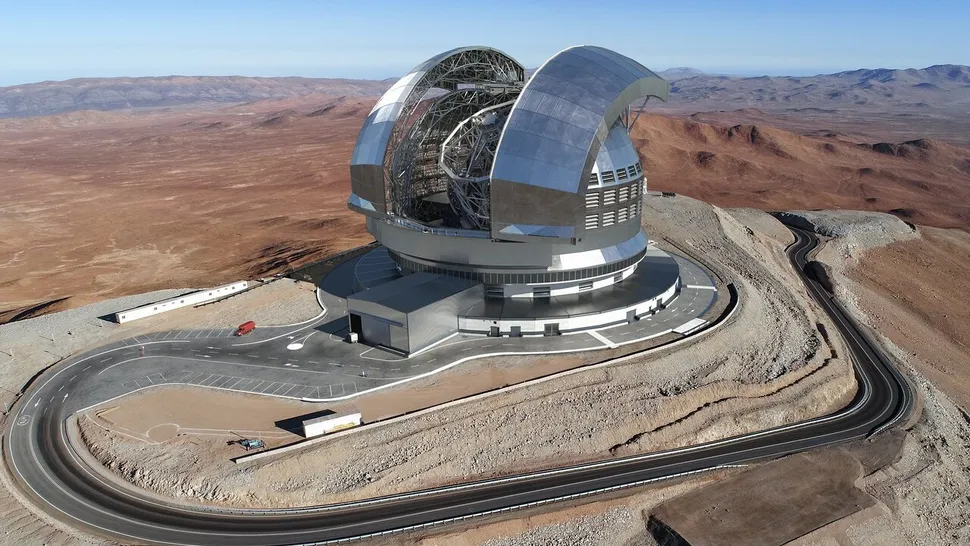Astronomers are sounding alarm bells as the world’s most precious sky-observing location faces a risk of being blinded by light pollution due to a planned renewable energy project.
The U.S. energy company AES Energy wants to build a large renewable hydrogen manufacturing complex in Chile, only a few kilometers from the summit of Mount Paranal, the site of the European Southern Observatory’s (ESO) Very Large Telescope (VLT).
VLT, which cost some $350 million to build in the 1990s ($840 million in today’s dollars), is one of the world’s most sensitive sky-watching instruments, capable of observing the most intriguing objects in the universe. The high-precision observatory consists of four 27-foot-wide (8.2 meters) telescopes that act as one, and has shed light on some of the most mysterious phenomena known to humankind. But the observing potential of this astronomical powerhouse will be significantly curtailed if the hydrogen project, called INNA, receives a go ahead, Xavier Barcons, ESO’s Director General, told Space.com.
“The brightness of the sky is going to increase by up to 10% from this project,” Barcons said. “And that is enough to make a difference between the best observatory in the world and an average observing place.”
Mount Paranal, an 8,740-foot-high (2,664 m) peak in the Atacama Desert of Northern Chile, is one of the last spots on Earth free from urban and industrial light pollution. Thanks to the unique geography of the Andes mountain range, the star-studded night sky above the summit is perfectly clear more than 11 months per year, providing perfect conditions for the most challenging astronomical research
“It’s the darkest place where we have ever set an observatory in the world, by a large margin,” Barcons said.
ESO, an intergovernmental organization comprising 16 European states, set its sights on Atacama more than 60 years ago, having opened its first observatory in Chile on the La Silla mountain, to the south of Paranal, in 1966. Paranal took over as the hub of European astronomy in the 1990s when the VLT was constructed.
So far, the VLT has allowed astronomers to trace orbits of stars in the nearest vicinity of the black hole at the center of the Milky Way galaxy, taken the first ever image of a planet outside the solar system and uncovered the elusive cosmic web that sprawls across the entire cosmos.
One of the reasons the VLT has been so prolific is the dark skies it was built under. A survey published in 2023 found that among the world’s 28 most powerful astronomical observatories, telescopes on Mount Paranal suffered from the lowest levels of artificial light pollution. The superior sky-observing conditions in the area led ESO to choose the neighboring Mount Armazones as a location of its next generation sky-observing super-machine — the Extremely Large Telescope (ELT).
Once completed toward the end of this decade, ELT will be the world’s largest telescope studying the universe in visible light, featuring a 130-foot-wide (39.3m) mirror.
The telescope, worth more than $1.5 billion, promises to expand the science done by the reliable VLT. It will provide even deeper views into the most distant universe but will also be able to gather detailed information about potentially habitable exoplanets. The light pollution expected from the INNA project could undo all that progress.
“We might lose the ability to observe about 30% of the faintest galaxies,” said Barcons. “We are at the point of starting to be able to see details of exoplanet atmospheres, but if the sky gets brighter, we may not be able to see those details anymore.”
The INNA project, a 3,021-hectare industrial park worth $10 billion, will consist of three solar farms, three wind farms, a battery energy storage system and facilities for the production of hydrogen, according to Renewables Now.
ESO estimates the complex will leak as much light pollution as a city with a population of about 20,000. Parts of the industrial park may extend as close as 3 miles (5 kilometers) to ESO’s telescopes, and any possible further expansion would further worsen the impacts on the Paranal night sky.
Expected to generate 217,023 metric tonnes of green hydrogen per year, the venture presents a conundrum for ESO. The organization itself has committed to reducing its carbon footprint and even built a 9-megawatt photovoltaic power plant to supply the Paranal and Armazones observatories with green power.
But Barcons states that while a project like INNA can easily find other suitable locations, for astronomers, there is only one Mount Paranal.
“These two things cannot be in the same place. It’s as simple as that,” said Barcons. “This clean hydrogen plant would be perfectly O.K. for us only 50 kilometers [31 miles] away. We don’t think there is any reason why it couldn’t be moved.”
AES Chile, the Chile-based subsidiary of the AES Corporation, submitted an environmental impact assessment to the Chilean Environmental Impact Agency in late December. The agency will conduct a public consultation before deciding about the project. In a statement issued on Dec. 30, 2024, AES Chile said that the project is in early stages and that no investment decision had yet been taken.
The company also stated that a “partnership with local communities and stakeholders is a top priority, ensuring we are supporting local economic development, while maintaining the highest environmental and safety standards.”
The company did not respond to Space.com’s request for comment.
ESO, in the meantime is calling for stricter legal protections of the Chilean night sky, especially in the vicinity of the precious observatories in the Atacama Desert. The Chilean government passed regulations in 2023 to control stray light emissions from outdoor lighting to protect the pristine night sky for astronomical observations. Barcons, however, says that more remains to be done.
Source: https://www.space.com/space-exploration/worlds-largest-telescope-threatened-by-light-pollution-from-renewable-energy-project



